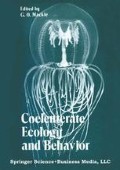Abstract
In classical treatments of their feeding biology, madreporarian corals are viewed as chiefly carnivorous (Hyman, 1940; Yonge, 1930). However, some recent studies indicate that hard corals may obtain their nutritional requirements by not one, but several means including autotrophy, particulate feeding and accumulation of dissolved organic material. For example, coral species which host endosymbiontic zooxanthellae accrue nutritional benefit in the form of soluble carbohydrates released by their algal guests (Lewis and Smith, 1971; Goreau, Goreau and Yonge, 1971). Sorokin (1972 and 1973) has confirmed that some scleractinian corals feed upon planktonic algae and bacteria. However, the nutritional role of dissolved organic matter in corals is less certain than autotrophy and particulate feeding. Studies by Stephens (1962) upon the hermatypic coral Fungia scutaria have demonstrated that under laboratory conditions, F. scutaria is capable of accumulating 14C-labelled glucose and amino acids from modest concentrations made available in seawater. Nonetheless, the significance of dissolved organic material in the nutrition of corals remains to be established because, to date, there have been no experiments in this regard carried out under natural field conditions. The experiments reported here were undertaken to determine whether the solitary coral Balanophyllia elegans Verrill will accumulate under in situ conditions, dissolved carbon exudated by the “large kelp” Macrocystis integrifolia.
Access this chapter
Tax calculation will be finalised at checkout
Purchases are for personal use only
Preview
Unable to display preview. Download preview PDF.
Literature Cited
Goreau, T. F., Goreau, N. I., and C. M. Yonge, 1971. Reef corals: autotrophs or heterotrophs? Biol. Bull., 141: 247–260.
Hyman, L. H., 1940. The Invertebrates: Protozoa through Ctenophora. Volume I. McGraw-Hill Company, New York. 696 pp.
Johannes, R. E., Coward, S. J., and K. L. Webb, 1969. Are dissolved amino acids an energy source for marine invertebrates? Comp. Biochem. Physiol., 29: 283–288.
Lewis, D. H., and D. C. Smith, 1971. The autotrophic nutrition of symbiotic marine coelenterates with special reference to hermatypic corals. Proc. Roy. Soc. London Series B, 178: 111–129.
Lobban, C. W., 1974. A simple, rapid method of solubilizing algal tissue for scintillation counting. Limnol. Oceanogr., 19: 356–359.
Sorokin, YU. I. 1972. Bacteria as food for coral reef fauna. Oceanology, USSR, 1: 169–177.
Sorokin, YU. I., 1973. On the feeding of some scleractinian corals with bacteria and dissolved organic matter. Limnol. Oceanogr., 18: 380–385.
Stephens, G. C., 1962. Uptake of organic material by aquatic invertebrates. 1. Uptake of glucose by the solitary coral, Fungia scutaria. Biol. Bull., 123: 648–659.
Yonge, C. M., 1930. Physiology of reef corals: feeding mechanisms and food. Scient. Rep. Gt. Barrier Reef Exped., 1: 13–57.
Author information
Authors and Affiliations
Editor information
Editors and Affiliations
Rights and permissions
Copyright information
© 1976 Springer Science+Business Media New York
About this chapter
Cite this chapter
Fankboner, P.V. (1976). Accumulation of Dissolved Carbon by the Solitary Coral Balanophyllia Elegans — an Alternative Nutritional Pathway?. In: Mackie, G.O. (eds) Coelenterate Ecology and Behavior. Springer, Boston, MA. https://doi.org/10.1007/978-1-4757-9724-4_12
Download citation
DOI: https://doi.org/10.1007/978-1-4757-9724-4_12
Publisher Name: Springer, Boston, MA
Print ISBN: 978-1-4757-9726-8
Online ISBN: 978-1-4757-9724-4
eBook Packages: Springer Book Archive

